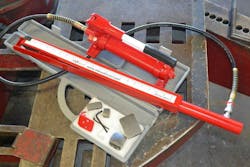HOW IT WORKS:
Scott Blake says it’s a situation every shop owner can relate to: You research a tool and do your due diligence in finding the best one, but sometimes, the tool just doesn’t live up to the hype and ends up gathering dust in the corner. As the president and owner of Blake’s Collision Center in LaPorte, Ind., Blake says he was skeptical method of repairing damaged frame rails, but decided to give it a shot.
When an adjuster came out to check on the frame damage on a truck, Blake mentioned the tool and said he could do the repair while the adjuster was in the shop. The truck was hit very hard in the rear and the frame was estimated at $3,000, but within 30 minutes, Blake says the first rail was already completely repaired. In total, the adjuster ended up paying Blake’s shop four hours of repair time per rail and what was initially a 10-day job only took the shop three days.
The way the tool works is simple: Instead of using a duck-bill spreader to repair frame rails and side members in unibody and full-frame vehicles, the tool uses a four-ton hydraulic ram to drive a wedge past another wedge to transfer that energy out to the side. Simply determine the depth of damage using the target at the end of the tape measure on the tool (it goes up to 27.5 inches inside a rail with 1.2 inches of expansion), determine if any wood or metal shims are necessary to avoid obstructions, and insert the tool into the damaged frame rail. Then hammer and level the high areas. The convex shape won’t cause protrusions in the repair and allows the metal to be pushed past the point of springback.
“Because of the way this tool is designed, it fits inside the frame rail end and you can then hammer and dolly that frame perfectly,” Blake says. “You will put it right back in the precise dimension that the frame was built with.”
The tool has been tested by General Motors and is approved for General Motors dealer-equipment program.
THE RETURN:
Blake says that he easily recouped the cost on the first vehicle, and even more so by the second, where he was paid eight hours total.
“That adjuster left here scratching his head,” he says. “It’s amazing that more people have not picked up on this tool or know more about it.”
Blake says it has allowed him to repair more vehicles that would otherwise be considered a total loss, and he’s able to repair them faster and without the expense of putting frame rail sections or full frames under these vehicles.
Blake does note that the tool isn’t right for every repair, however.
“It’s not a fix-all cure, by any stretch, but if it is repairable, this tool is going to do the repairs for you,” he says.
The tool is right for vehicles where the OEM recommendation is that it’s repairable, and if the frame is bent and doesn’t contain a kink. While a bend can be repaired, kinks are not repairable and will crack in the repair process.



